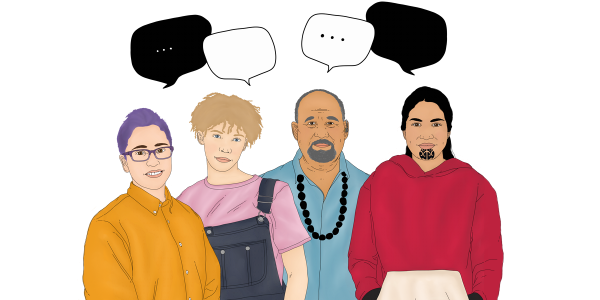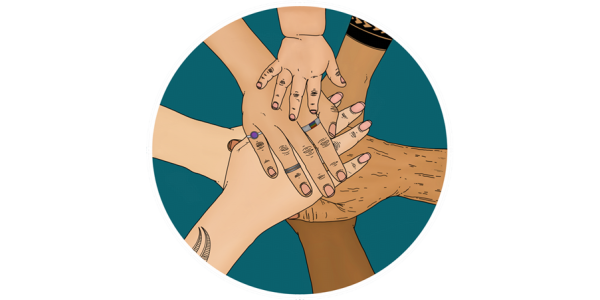An elevator pitch is a short narrative about your project that can be used in a couple of different ways: to engage people to contribute to the improvement project and as a tool for socialising and promoting work through face-to-face interactions, leaflets or posters.
When creating an elevator pitch specifically to engage people, your aim is to produce a brief persuasive speech to help people understand:
- the challenge or opportunity you are exploring
- why you want to engage them in this work
- how they can contribute through their expertise in delivering or receiving health and care services
- what happens next.

Image credit: Huriana Kopeke-Te Aho
Steps for developing an elevator pitch to engage people
- Outline the challenge or opportunity for improvement.
- Share the high-level goal of the improvement project and why the project is important to the organisation/ward/department and to you personally.
- Clearly invite the person/group to contribute and state what specific expertise or knowledge they have that is essential for success.
- Describe how and when you would like them to contribute.
- Ask them if they would like and be able to contribute.
Tips for an ideal elevator pitch
- Make it short – no longer than two minutes.
- Consider who the pitch is intended for. You may need different versions for consumers, whānau, staff and other potential stakeholders.
- Make it feel personal. Write it as you would say it rather than as a standard paragraph in a project document. It is a kind of script, but the way it is delivered is very important.
- Don’t use jargon or abbreviations.
- Test your elevator pitch before using it with consumers, whānau, staff and other stakeholders. Read it aloud and time yourself. Ask others to listen and give you feedback on what they understand about the work and what you are asking of participants. It’s usual to refine the pitch a number of times.
Remember, your pitch needs to be short, engaging, informative and compelling. If people require more information, that can be added within the conversation.
Examples of elevator pitches
Elevator pitch for paediatric outpatient families
The starting point before changes were made
We would like to find out what you think about the services we provide for children with chronic illness in the paediatric outpatient area. This includes talking about medical and nursing care, access to the services you and your child need and support for their wellbeing, like their emotional health and avoiding extra family stress.
We are contacting families, asking them to share stories and ideas with us. We want to continue to develop our service to provide the best care for your child.
This elevator pitch provides a basic narrative, but it lacks an initial introduction from the staff member and an actual request of the consumer to find out whether they are happy to talk.
Always use simple language to aid understanding; for example, the term ‘chronic illness’ is more familiar to staff than to the general population.
This pitch doesn’t include any information about how the staff member might want to gather the consumer’s perspective or how long it might take. It is important to provide consumers enough information for them to understand what they are agreeing to do.
As you read through the following examples, carefully examine the differences between the initial versions and the post-test versions.
Version post testing
Kia ora/mālō e lelei/hello, my name is … and I work at the hospital.
Could I chat to you about a project we are doing here in outpatients?
We want to continue to develop our service to provide the best care for you and your child. So, we are contacting families like you and asking if you will share your stories and ideas with us.
We would like to find out what you think about the services we provide in the paediatric outpatient clinic. This includes talking about how you have or have not been able to get the services you and your child need, and support for your wellbeing when your child is unwell; for example, emotional health, including stress. We would like to spend 20 to 30 minutes with you to chat through five questions and to allow time for you to add any other points that are important to you. We could do that here today while you are waiting (don’t worry you will not miss your appointment), or we could arrange to do it at another time, including over a telephone call.
[Add specific details about confidentiality, that no names will be used and ‘where and when’ if the person chooses not to talk on that day.]
Version to engage staff
Kia ora/mālō e lelei/hello Carol, do you know anything about the project we are doing here in outpatients to understand how it feels to work in the clinic and what the experience is like for families who come to the clinic with sick children?
[Pause and adjust the level of detail as appropriate.]
We would like to find out what you think about the services we provide in the paediatric outpatient clinic. This includes talking about what it feels like from your perspective to provide care, for example, what delights you and what you might find frustrating.
We are arranging a couple of small focus groups where four or five staff can come together to share their thoughts, and we are also meeting a few people individually if they prefer. Each would be for 30 minutes to chat through five questions and to allow time to add any other points that are important to you. We could meet in the hospital or outside at a time that works for you. Would you be willing to share your thoughts with us?
[If the person agrees, confirm whether they would prefer a focus group or individual kōrero.]
[Specific details about confidentiality should be added here.]
Oral care for pregnant women – a starting point
We want to work with pregnant women like you so we can help to make sure your mouth is as healthy as possible before you have your baby and to try and stop dental diseases passing on to the baby.
Our aim is to encourage women to visit a dental clinic during pregnancy to improve their oral health and increase referrals to an OHST clinic.
The tone of this elevator pitch may make the person feel they are being blamed for something. Always avoid this.
Version post testing
Kia ora/mālō e lelei/hello, my name is … and I work in dental services here at XX community.
Do you have a moment for me to chat to you about a project we are doing about free dental check-ups?
We want to help all mums to have the healthiest mouth possible and reduce the risk of having any dental problems during their pregnancy; this in turn will help babies start their life with a healthy mouth too.
Did you know that you are able to have a free visit to the dental clinic and for a check-up for your baby when they are 12 months and 18 months old? If you do, that’s great, and we would like to chat through any experiences you have had with the service.
If you did not know that don’t worry, we can tell you about it.
We would like to work with you and other mums to understand what would make it easy for you to use the free dental check-ups that are available. To do this, we could arrange a chat just with you or with others in a small group who are around the same stage of pregnancy as you. We can meet in a place that feels comfortable and at a time that works for you. We have a few questions, but there would be time for you to tell us anything else too.
Would you be interested in talking to us?’
[Specific details about confidentiality should be added here.]
Version to engage staff
Kia ora/mālō e lelei/hello Sally, as I mentioned in the team meeting, we are starting a project to better understand why mums are not able to come to the free dental checks. We know that oral health is important for both mum and baby, but some people in our community are at risk of developing poor oral health. To do this, we are asking mums to talk to us from their perspective, but we also want to hear what experienced midwives like you think. We have a few questions but also want your thoughts overall. The chat would take place in a private space, either here in the ward or somewhere else that works for you.
Would you have about 20 minutes to talk to us about this, either now or at another time and day that works for you?
[Specific details about confidentiality should be added here.]

Image credit: Huriana Kopeke-Te Aho
Useful reading
Bohns V. 2017 April 11. A face-to-face request is 34 times more successful than an email. Harvard Business Review Business Writing Series. URL: https://hbr.org/2017/04/a-face-to-face-request-is-34-times-more-successful-than-an-email (accessed 26 May 2017).
Dimopoulos-Bick TL, O'Connor C, Montgomery J, et al. 2019. “Anyone can co-design?”: A case study synthesis of six experience-based co-design (EBCD) projects for healthcare systems improvement in New South Wales, Australia. Patient Experience Journal 6(2): 93–104. DOI: 10.35680/2372-0247.1365.
Goodyear-Smith F, Jackson C, Greenhalgh T. 2015. Co-design and implementation research: Challenges and solutions for ethics committees. BMC Medical Ethics 16: 78. DOI: 10.1186/s12910-015-0072-2.
Health Quality & Safety Commission. 2015. Policy of Paying Consumers. URL: https://www.hqsc.govt.nz/assets/Consumer-Engagement/Resources/policy-paying-consumers-Mar-2015.pdf (accessed 26 August 2017).
Maher L, Hayward B, Hayward P, Walsh C. 2017. Increasing patient engagement in healthcare service design: A qualitative evaluation of a co-design programme in New Zealand. Patient Experience Journal 4(1): 23–32. DOI: 10.35680/2372-0247.1149.
Mark S, Hagen P. 2020. Co-design in Aotearoa New Zealand: A snapshot of the literature. Auckland Co-design Lab, Auckland Council. URL: chrome-extension://efaidnbmnnnibpcajpcglclefindmkaj/https://knowledgeauckland.org.nz/media/1900/co-design-in-aotearoa-new-zealand-a-snapshot-of-the-literature-s-mark-p-hagen-tsi-june-2020.pdf.
Polit DF, Beck CT. 2008. Nursing research: Generating and assessing evidence for nursing practice (8th ed). Sydney, Australia: Lippincott, Williams & Wilkins.
Sinek S. 2010. Start With Why – How Great Leaders Inspire Action. URL: https://www.ted.com/talks/simon_sinek_how_great_leaders_inspire_action (accessed 16 December 2022).
Szalay N. (nd). Give your elevator speech a lift. URL: https://www.isixsigma.com/implementation/communication/give-your-elevator-speech-a-lift/.
